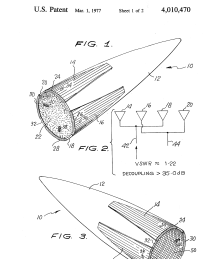Howard S. Jones Jr.
Howard Jones invented conformal antennas – lightweight antennas found in rockets, missiles and spacecraft. His innovations in antenna technology dramatically expanded the capabilities of U.S. defense and space systems, and continue to influence defense systems to this day.
Jones was born in Richmond, Virginia, in 1921. He didn’t realize his immense talent and passion for science until he entered Virginia Union University, where his mother had encouraged him to enroll. He earned his bachelor’s degree in mathematics and physics in 1943, but it was only after his graduation that he decided to pursue engineering. He would later earn his master’s degree in electrical engineering from Bucknell University in 1973.
At the beginning of World War II, with engineers in high demand, Jones entered a Howard University government training program that qualified him as a junior engineer and took a job as an engineer at the National Bureau of Standards (NBS), which is now the National Institute of Standards and Technology in Washington, D.C. In 1944, he was drafted into the U.S. Army and began teaching basic mechanical engineering courses to commissioned and noncommissioned officers.
Although he later served as a Signal Corps specialist and was offered an officer’s position by the Army, Jones decided to focus on research again after the war. He returned to NBS as an electronic physicist at Harry Diamond Laboratories (now part of the U.S. Army Research Lab) in Adelphi, Maryland. Here, he became a specialist in antenna systems and weapon fuses.
Jones was encouraged by his supervisors to invent as prolifically as Jacob Rabinow, a renowned inventor at NBS. He rose to the challenge, acquiring roughly one patent each year from the 1950s through the 1970s. His many patented inventions included the radar fuse antenna systems used in the majority of missiles produced by the Army during that time.
Prior to Jones’ work, most antennas — vital for the guidance of military, air, space and weapon fusing systems — were added separately on to the structures they enhanced. However, this practice created drag during flight. So Jones focused on creating antenna arrays designed to conform to the aerodynamic shape of a projectile, resolving challenges related to size, weight, volume and electrical properties.
With his first patent on conformal antennas, Jones launched the development of a class of antennas that achieved his vision and reduced – or even eliminated – the problem of drag. Unlike previous antennas, conformal antennas improved electrical performance and reduced both weight and cost.
Jones’ lightweight arrays benefited spacecraft, including Voyager, and many military systems. Jones also contributed to the smart skin technology developed for radar-evading, stealth technology aircraft, and he designed and developed state-of-the-art microwave, radiofrequency, VHF and multifrequency antennas.
While Jones worked for the Army for more than 20 years, he strongly believed in technology transfer, participating with university and industry researchers in developing new microwave and antenna technology. He authored more than 40 scientific papers, gave numerous presentations at national and international conferences, and spoke at many universities and professional society meetings.
Jones retired as chief of microwave research at the Harry Diamond Laboratories in 1980. He had earned more than 30 patents over the course of his career. A recipient of many awards, Jones was given the IEEE Harry Diamond Award in 1985 and an honorary degree from Trinity College in 1997, and he was elected to the National Academy of Engineering in 1999.
An advocate for accessible education, Jones was particularly interested in helping underrepresented students study mathematics and science. He spent countless hours tutoring and mentoring students, and preparing them to pursue careers in engineering.

